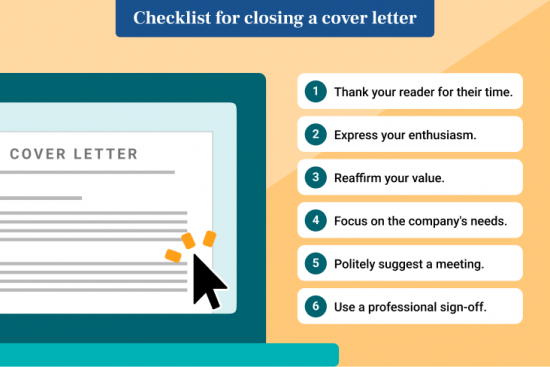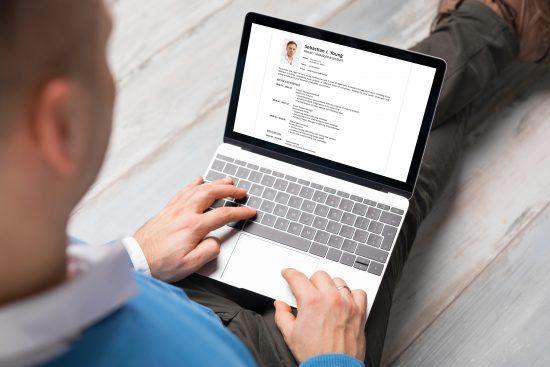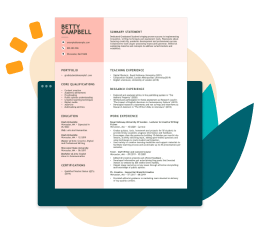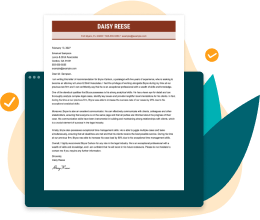How to Start a Cover Letter: 35 Examples
An attention-grabbing cover letter opening can help win you the job! Here, we’ll provide examples, templates, strategies and step-by-step guidance to start a cover letter that stands out.
How to start your cover letter
You must capture a hiring manager’s attention to win a job, and a strong cover letter opener is how you get them hooked! Its goal is to get them excited to learn more about you and why you’re a good fit for the role.
Now, if you’re wondering how do I start my cover letter?
- List your name and contact information in the header.
- Address your letter to the hiring manager by name.
- Cite the job you want in the opening sentence.
- Feature your top skills and reason(s) you deserve the job in the first paragraph.
Nailing the first paragraph may be the trickiest part. To write a great cover letter, you need a clear, compelling introduction that gives convincing reason(s) to be excited about your candidacy.
We’ll show you how with some cover letter examples and the step-by-step process of starting your cover letter strong.
But if you want next-level help, check out our Cover Letter Generator. It’s a tool that makes creating your cover letter easier!
That’s because it features a database of expert-written cover letter openers you can select and add with a single click! Best of all, the written content targets the job title you’re applying for.
How to start a cover letter using templates
Here are three effective ways to start your cover letter. They’re templates so you can copy/paste and personalize them in your letter!
Choose one to start a cover letter that best fits your application:
Highlighting relevant experience:
“As an accomplished professional with a track record of [mention a relevant achievement or skill], I am excited to apply for the [job title] position at [Company Name]. With [number of years] years of experience in [mention relevant industry or field], I am confident in my ability to [mention key responsibilities or tasks from the job description]. I am drawn particularly to [aspect of the company or role that excites you], and I am eager to leverage my skills and talents to contribute to your team’s success.
Who should start a cover letter this way:
Employers want job applicants with the right experience, so this template has universal appeal and is appropriate for everyone. It will benefit you to mention the skills or experience the employer has requested for the job advertisement or post!
Expressing enthusiasm and alignment with company values:
“This letter shares my excitement for the opportunity to join [Company Name] as a [job title]. As someone deeply passionate about [mention relevant industry or field], I’m impressed by [Company Name]’s dedication to [mention a specific aspect of the company’s mission, values, or work]. With a background in [mention relevant experience or skill], I am excited about contributing to your team and making a positive impact. This opportunity would be a dream come true, and my experience and values make me a perfect fit.
Who should start a cover letter this way:
This type of cover letter opener is fitting for anyone with a passion for a company and its mission! Employers want people excited to work for them, so it’s an attention-grabbing opener.
Mentioning a networking connection or reference:
“I am writing to express my interest in the [job title] position at [Company Name], as recommended by [Referral Name]. With a passion for [relevant field or industry], coupled with [number of years] years of experience in [mention relevant experience or skill], I would relish the opportunity to contribute to your team. I have long admired [Company Name]’s commitment to [mention a specific aspect of the company or its work], and hope to bring my skills and enthusiasm to your esteemed organization.
Who should start a cover letter this way:
This opener is for people with a networking connection to a company or hiring manager who has recommended you apply. Skip using it if you don’t. Also, ensure the person you mention is comfortable serving as your reference.
Next, we’ll show more examples of how to start your cover letter, organized by strategy and job title.
How to start a cover letter: 32 opener examples + strategies
Your cover letter opening aims to grab the attention of the person reading it. There are different ways you could approach this!
We’ll provide examples and outline the four top strategies for appealing to a hiring manager. They include:
Starting a cover letter by selling your passion.
Employers want people who are passionate about their jobs, so this is a failsafe strategy for opening your cover letter.
This strategy benefits people without much work experience because your enthusiasm and eagerness can often make up for how many jobs you’ve had.
Check out these passionate cover letter openers for different types of jobs:
Software engineer:
Passionate about pushing the boundaries of technology, I am excited to apply for the Software Engineer role at [Company Name]. With a strong background in developing cutting-edge software solutions and a commitment to continuous learning, I am enthusiastic about the opportunity to contribute to your mission of delivering exceptional digital experiences.
See more: Software engineer cover letter examples
Registered Nurse:
Dedicated to providing compassionate care and improving patient outcomes, I am enthusiastic about the opportunity to join the nursing team at [Hospital Name]. With a deep commitment to patient advocacy and a proven ability to thrive in fast-paced healthcare environments, I am eager to leverage my clinical expertise to make a meaningful difference in people’s lives.
See more: Registered nurse cover letter examples
Graphic designer:
Driven by a passion for visual storytelling and creative expression, I am excited to apply for the Graphic Designer position at [Company name]. With a keen eye for aesthetics and a portfolio showcasing my diverse design projects, I am eager to collaborate with your team to bring innovative ideas to life and elevate your brand’s visual identity.
See more: Graphic designer cover letter examples
Digital marketing manager:
As a fervent advocate for innovative online strategies, I am thrilled to apply for the Digital Marketing Manager position at [Company Name]. With a proven track record of driving brand awareness and increasing customer engagement, I am eager to bring my creative vision and strategic insights to your dynamic team.
See more: Digital marketing manager cover letter examples
Environmental consultant:
Committed to preserving our planet’s natural resources and mitigating environmental impact, I am thrilled to apply for the Environmental Consultant role at [Environmental Consulting Firm]. With a background in conducting comprehensive ecological assessments and developing sustainable solutions, I am excited about the opportunity to contribute to your efforts in creating a greener, more sustainable future.
See more: Environmental consultant cover letter examples
Financial analyst:
Passionate about uncovering insights and driving informed financial decisions, I am excited to apply for the Financial Analyst position at [Financial Services Firm]. With a strong analytical mindset and a track record of delivering actionable financial recommendations, I am eager to leverage my expertise to help your clients achieve their financial goals.
See more: Financial analyst cover letter examples
Elementary school teacher:
Empowered by my lifelong love of learning and a desire to empower young minds, I am enthusiastic about the opportunity to join the teaching team at [School Name]. With a nurturing approach to education and a dedication to fostering a positive learning environment, I am devoted to my students’ academic and personal growth. With confidence, I believe my teaching background and commitment would make me a valuable part of your team.
See more: Elementary teacher cover letter examples
Human resources manager:
Passionate about cultivating inclusive workplaces and supporting employee development, I am thrilled to apply for the Human Resources Manager position at [Company Name]. With a proven ability to implement strategic HR initiatives and foster a culture of collaboration and respect, I am eager to partner with your leadership team to attract, retain, and develop top talent.
Starting a cover by showing admiration.
Businesses want to hire people who care and align with their values and goals. So, showcasing your respect and admiration for a company can be an effective strategy for winning a position with them.
Check out these admiration-focused cover letter openers for different job titles.
Customer service representative:
As a friendly and dedicated advocate for exceptional customer experiences, I am thrilled to apply for the customer service representative position at [Company Name]. Your unwavering commitment to putting customers first and delivering unparalleled service resonates deeply with my values, and I am eager to contribute to your mission of exceeding customer expectations.
See more: Customer service representative cover letter examples
Social media coordinator:
I am excited to apply for the social media coordinator role at [Company Name]. I genuinely admire your company’s innovative approach to digital engagement. Your commitment to authenticity, creativity and community-building aligns perfectly with my knack for leveraging social media as a powerful tool for connecting with audiences and driving meaningful conversations.
See more: Social media coordinator cover letter examples
Project manager:
Inspired by your company’s track record of successfully delivering impactful projects and driving positive change, I am enthusiastic about the opportunity to join your team as a project manager. Your emphasis on collaboration, integrity, and excellence mirrors my professional values, and I am eager to contribute my skills and expertise to help achieve your ambitious goals.
See more: Project manager cover letter examples
Sales representative:
As a sales professional with a deep respect for your company’s innovative products/services and dedication to customer satisfaction, I am excited to apply for the sales representative position at [Company Name]. Your reputation for integrity, transparency, and personalized solutions resonates strongly with me. I am eager to optimize sales, drive growth and build lasting client relationships.
See more: Sales representative cover letter examples
Content writer:
Attracted by your company’s commitment to delivering high-quality content that informs, educates, and inspires, I am excited to apply for the content writer role at [Company Name]. Your emphasis on creativity, authenticity, and thought leadership harmonizes perfectly with my approach to crafting compelling narratives and engaging audiences across various platforms.
See more: Content writer cover letter examples
IT specialist:
With a deep respect for your reputation leveraging technology to streamline operations and drive innovation, I am eager to apply for the IT specialist position at [Company Name]. Your commitment to staying at the forefront of technological advancements and providing reliable support to your team resonates strongly with my creative IT troubleshooting and problem-solving abilities.
See more: IT Specialist cover letter examples
Event coordinator:
Your company’s renown for organizing memorable events that leave a lasting impression on attendees makes me enthusiastic about the opportunity to join your team as an event coordinator. Your focus on creativity, attention to detail, and seamless execution aligns perfectly with my expertise in planning and executing successful events that exceed expectations.
See more: Event coordinator cover letter examples
Research assistant:
Drawn to your company’s dedication to advancing knowledge and driving innovation in [specific field], I am excited to apply for the research assistant position at [Company Name]. Your commitment to rigorous research methodologies, ethical standards, and collaborative teamwork resonates deeply with my desire to contribute to meaningful research projects and positively impact the field.
See more: Research assistant cover letter examples
Starting your cover letter showcasing your achievements and skills.
Nothing speaks louder to a hiring manager than incredible career achievements and qualifications. So, a powerful strategy is to launch your cover letter by highlighting your most significant accomplishments.
Here are great achievement-focused cover letter openers for various jobs:
Executive assistant:
With a proven track record of seamlessly managing high-level administrative tasks and supporting executive teams in achieving their goals, I am excited to apply for the executive assistant position at [Company Name]. Throughout my career, I have consistently demonstrated exceptional organizational skills, resourcefulness, and a commitment to excellence, resulting in streamlined operations and enhanced productivity for the teams I support.
See more: Executive assistant cover letter examples
Senior accountant:
As a seasoned accounting professional with a solid foundation in financial analysis, budgeting, and risk management, I am eager to bring my expertise to the senior accountant role at [Company Name]. My track record of driving process improvements, implementing cost-saving strategies, and delivering accurate financial reports has positioned me as a trusted advisor and strategic partner within previous organizations.
See more: Senior accountant cover letter examples
Operations manager:
With a comprehensive background in operations management, process optimization, and team leadership, I am excited to apply for the operations manager position at [Company Name]. Throughout my career, I have successfully orchestrated complex projects, streamlined workflows, and fostered a culture of continuous improvement, resulting in significant cost savings and operational efficiencies for my employers.
See more: Operations manager cover letter examples
Software developer:
As a highly skilled software developer with a passion for innovation and a proven ability to deliver high-quality solutions, I am thrilled to apply for the software developer opening at [Company Name]. With expertise in full-stack development, Agile methodologies, and cutting-edge technologies, I have consistently delivered robust software products that meet and exceed client expectations, earning accolades for my technical prowess and collaborative approach.
See more: Software developer cover letter examples
Marketing coordinator:
With a dynamic blend of creativity, strategic thinking and analytical acumen, I am excited to apply for the marketing coordinator role at [Company Name]. Throughout my career, I have spearheaded successful marketing campaigns, leveraged data-driven insights to optimize performance, and cultivated strong brand identities that resonate with target audiences, increasing my employers’ market share and revenue growth.
See more: Marketing coordinator cover letter examples
Quality assurance specialist:
As a detail-oriented quality assurance specialist passionate about ensuring product excellence and customer satisfaction, I am eager to apply for the Quality Assurance Specialist position at [Company Name]. With a proven track record of implementing rigorous testing protocols, identifying and resolving defects, and maintaining regulatory compliance, I have played a pivotal role in delivering high-quality products and driving continuous improvement initiatives.
See more: Quality assurance cover letter examples
Human resources coordinator:
With a solid foundation in human resources management, employee relations, and talent acquisition, I am excited to apply for the human resources coordinator role at [Company Name]. Throughout my career, I have successfully implemented HR policies and procedures, facilitated training and development initiatives, and fostered a positive work environment that supports employee engagement and retention, contributing to the overall success of the organizations I’ve served.
See more: HR coordinator cover letter examples
Supply chain manager:
As a strategic supply chain professional with a proven track record of optimizing logistics operations, reducing costs, and enhancing supply chain efficiency, I am enthusiastic about the opportunity to apply for the supply chain manager position at [Company Name]. With expertise in inventory management, vendor relations, and process reengineering, I have consistently delivered measurable results and driven continuous improvement initiatives that position my employers for success in a competitive marketplace.
Starting your cover letter creatively.
In rare cases, companies may value unique personality, outside-the-box or creative thinking. Having a creative cover letter opener can be helpful in these cases!
Here are examples of creative cover letter openers for different jobs:
Photographer:
As a wildlife photographer, I’ve always believed that each click of the shutter captures not just an image but a moment of raw beauty and untamed emotion. My passion for preserving the natural world through photography has led me to explore remote landscapes and observe elusive creatures in their habitats. I am eager to share my lens’s perspective with [Company Name] and contribute to your environmental conservation and storytelling mission through visual art.
See more: Photographer cover letter examples
Video editor:
As the curtain rises on the digital stage, I step into the limelight with a passion for storytelling and a flair for visual orchestration. I am thrilled to apply for the video editor position at [Company Name], where creativity meets innovation. Like a director shaping scenes, I craft narratives that captivate, inspire, and leave audiences craving more. With every frame meticulously polished and every transition seamlessly choreographed, I immerse myself in the art of video editing, transforming raw footage into cinematic masterpieces.
See more: Video editor cover letter examples
Tour guide:
As an adventure tour guide, I live for the thrill of exploration and the joy of sharing unforgettable experiences with others. Leading intrepid travelers off the beaten path and into the heart of adventure has been my passion for years. I am excited about the opportunity to bring my expertise and enthusiasm to [Company Name] and create memorable journeys that inspire and delight adventurers of all ages.
See more: Tour guide cover letter examples
Videographer:
This letter expresses my excitement about the videographer opportunity at [Company Name]. It’s the perfect fit for my creativity and technical expertise to produce captivating video content that resonates with audiences and elevates the brand’s digital presence. With a passion for visual storytelling and a keen eye for detail, I thrive in the dynamic world of videography, where every frame is an opportunity to capture emotion and convey a compelling narrative. I’ve honed my craft through years of experience, mastering the art of cinematography, editing, and post-production to bring stories to life on screen.
See more: Videographer cover letter examples
UX designer:
I am excited to apply for the UX designer position at [Company Name], where user-centricity reigns supreme and creativity knows no bounds. As an architect of digital experiences, I thrive on the intersection of empathy and innovation, sculpting interfaces that bridge the gap between user needs and elegant design solutions. Like a sculptor with pixels, I mold wireframes and prototypes into intuitive journeys, each interaction a brushstroke in a canvas of seamless usability. With a deep understanding of human behavior and a passion for problem-solving, I craft experiences that delight users and elevate brands to new heights.
See more: UX designer cover letter examples
SQL developer:
I am a code architect in the decentralized blockchain world, building the foundations of a trustless future. With a background in software development and a keen interest in blockchain technology, I am excited about the opportunity to join [Company Name] as an SQL developer and contribute to producing innovative blockchain solutions. From smart contracts to decentralized applications, I am passionate about leveraging blockchain to create a more secure and transparent digital society.
See more: SQL developer cover letter examples
Visual effects artist:
I am thrilled to apply for the visual effects artist position at [Company Name], where innovation ignites creativity and magic is a daily occurrence. In the realm where imagination meets technology, I thrive as a visual enchantment wizard, weaving spells of awe and wonder with every pixel I command. Like an alchemist of the digital age, I blend technical expertise with boundless creativity to conjure illusions that defy reality and captivate audiences. Whether sculpting fantastical creatures or orchestrating explosive spectacles, my passion for storytelling and a relentless pursuit of perfection guides my work.
See more: Visual effects artist cover letter examples
Fashion model:
I am excited to apply for representation as a fashion model at [Agency’s Name], where creativity thrives and beauty knows no bounds. I embody elegance, grace, and style with every careful but casual step on the runway. As a canvas for couture, I bring to life the visions of designers, infusing each garment with personality and allure. With a portfolio adorned with diverse looks and expressions, I am adept at embodying a brand’s spirit while adding my unique flair. From high fashion editorials to glamorous catwalks, I am committed to exuding confidence, professionalism, and an unwavering dedication to the craft of your agency.
See more: Fashion model cover letter examples
How to start a cover letter: formatting steps
Before jumping straight into the writing, start your cover letter by covering the basic formatting details and addressing your document.
Follow these steps:
STEP 1
Formatting your cover letter.
Your cover letter must be correctly formatted to be easily read and understood. Adhering to these guidelines will also help ensure that you pass the scan of an applicant tracking system (ATS), which software companies use to filter job applications.
Follow these cover letter formatting guidelines:
- One-inch margins on all sides of the document
- Line spacing between 1.15-1.5
- A font size between 11-13
Then, organizationally, here’s the structure of a cover letter format:
- A heading
- The employer’s address
- A greeting
- Three to four body paragraphs
- A sign-off phrase
STEP 2
Add your contact information in the header.
To ensure the employer reading your cover letter knows who you are and how to reach you, including your contact information in your cover letter header is standard.
Include the following:
- Your name
- Your phone number
- A professional email address
- Optional: Your city/state location
- Optional: A professional title, e.g., “Marketing Manager” or “CPA”
STEP 3
Address your cover letter to the hiring manager.
Listing the business address you’re applying to is a formal step to confirm you’re reaching the right place.
Even more helpful is to use the name of the hiring manager who will review your documents. It’s a powerful way to connect and start your cover letter on the right foot.

PRO TIP
Take the time to find out the manager’s name responsible for the hiring decision. It will pay off to search on the company website or Linkedin. You could also call or email to ask.
Then, list the address and greeting like this:
[Company Name]
[Company Address Line 1]
[Company Address Line 2 (if applicable)]
[City, State ZIP Code]
Dear [Hiring Manager’s Name],
How to start a cover letter without name
Sometimes, you may need help finding the hiring manager’s name. When this happens, avoid generic and dated greetings like “Dear Sir or Madam” or “To Whom this may concern.”
Instead, consider the following options:
- Dear Hiring Manager,
- Dear [eg. Finance or Marketing] Department,
- Dear [Company Name] Team,
- Dear [Name of Department] Manager,
- Dear [Company Name] Recruiter,
STEP 4
Craft a compelling cover letter opening sentence.
The first sentence of your cover letter is where it begins! Flex your communication skills by being clear, convincing and friendly.
However, remember that the first sentence of your cover letter should convey two crucial bits of information:
- You desire a job and the name of the position you want.
- How you heard about the open position (if applicable).
Here’s a basic example: “This letter is to share my interest in the Acme Labs research position as posted on LinkedIn.”
That’s just the tip of the iceberg, though! Review the examples above or visit our page on how to write the first paragraph of your cover letter for more guidance!
Key takeaways
To recap, here are a few main points about how to start off a cover letter:
- Use proper cover letter formatting for readability.
- Personalize your letter by addressing it to the hiring manager by name.
- Be clear about mentioning the exact role you want and where you learned about it in the opening paragraph.
- Ensure your opening paragraph contains clarity, conviction, and friendliness.
- Aim for a compelling opener that makes you stand out from the competition.
- Different opener strategies include: Sharing your passion, showing admiration for the company, showcasing your achievements or being creative.
If you’re ready to tackle your cover letter, use the best tools possible. Unlock your potential for landing your dream job with LiveCareer’s Cover Letter Generator.
Create a professional, tailored cover letter highlighting your skills and experiences in a few quick minutes!
It’ll help you stand out and impress hiring managers with 25+ customizable templates and step-by-step expert guidance. Start building your winning cover letter today and take the first step toward career success!
Featured in:*

*The names and logos of the companies referred to in this page are all trademarks of their respective holders. Unless specifically stated otherwise, such references are not intended to imply any affiliation or association with LiveCareer.













